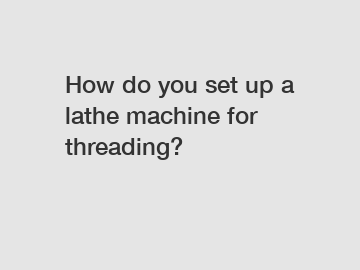How do you set up a lathe machine for threading?
Setting up a lathe machine for threading is a crucial process that requires precision and attention to detail. Threading is a common operation in metalworking that involves cutting internal or external threads on a workpiece. With the right setup, you can achieve accurate and consistent threading results on a lathe machine. In this article, we will discuss the steps involved in setting up a lathe machine for threading.
Selecting the Right Cutting Tool.
The first step in setting up a lathe machine for threading is selecting the right cutting tool. The cutting tool used for threading should have the correct thread profile to match the desired thread pitch and form. Common types of cutting tools used for threading include single-point threading tools, inserts, and thread mills. It is important to choose a cutting tool that is sharp and in good condition to ensure clean and accurate cuts.

Setting the Speed and Feed Rates.
Once you have selected the proper cutting tool, the next step is to set the speed and feed rates on the lathe machine. The speed at which the workpiece rotates and the rate at which the cutting tool advances along the workpiece can have a significant impact on the threading operation. It is essential to consult the lathe machine's manual and threading charts to determine the appropriate speed and feed rates for the specific material and thread pitch being used.
Securing the Workpiece.
Before starting the threading operation, it is crucial to secure the workpiece in the lathe machine. Properly mounting the workpiece ensures that it remains stable and concentric during the threading process. Depending on the size and shape of the workpiece, different methods such as chucking, collet holding, or between centers may be used to secure the workpiece in the lathe machine.
Setting the Thread Depth and Starting Point.
To accurately thread a workpiece on a lathe machine, it is important to set the thread depth and starting point properly. The thread depth refers to the distance the cutting tool should travel into the workpiece to create the desired thread profile. The starting point determines where the cutting tool should begin the threading operation. Carefully adjusting the thread depth and starting point ensures that the threads are cut to the correct specifications and alignment.
Engaging the Threading Operation.
Once you have completed the necessary setup steps, you can engage the threading operation on the lathe machine. Start the lathe machine and slowly advance the cutting tool towards the workpiece to begin cutting the threads. It is essential to monitor the cutting process and make any necessary adjustments to the speed, feed rates, or cutting tool position to ensure smooth and accurate threading.
Checking the Threaded Workpiece.
After completing the threading operation, it is crucial to check the threaded workpiece for quality and accuracy. Use thread gauges or calipers to measure the thread pitch, form, and depth to ensure that the threads meet the required specifications. Make any necessary adjustments or corrections to the threading setup if deviations are found during inspection.
In conclusion, setting up a lathe machine for threading requires careful planning and attention to detail. By selecting the right cutting tool, setting the appropriate speed and feed rates, securing the workpiece, and accurately setting the thread depth and starting point, you can achieve precise and consistent threading results on a lathe machine. If you need assistance with setting up a lathe machine for threading, feel free to contact us for expert guidance and support.
If you want to learn more, please visit our website open hole drill pipe protectors, tubing casing bucking machine, pipe thread protector caps.

Comments
0